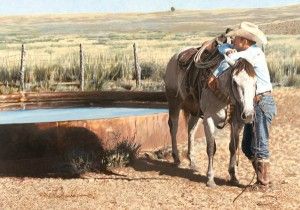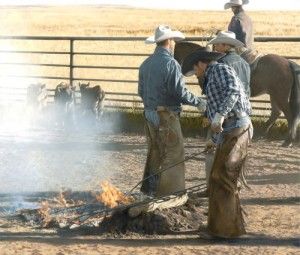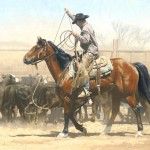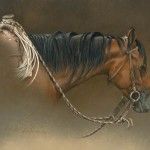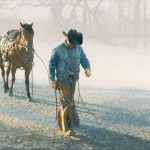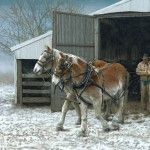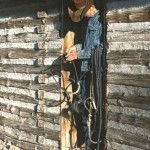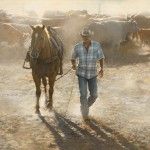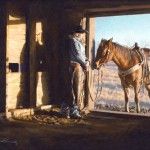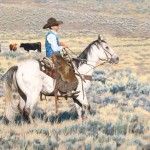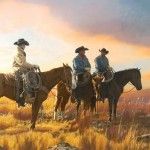By Mark Mussari
Western artist Mikel Donahue was born and raised in Tulsa, OK, but his fondest childhood memories involve his paternal grandparents’ ranch in north-central Oklahoma, outside of Sand Creek. “I had the best of both worlds,” he recalls, “going to school in town and playing sports, and then spending summers at the ranch.”
When he was seven years old, Donahue had a life-changing experience at his grandfather’s ranch. It was evening, and his father and grandfather kept going out to the barn periodically. Like any curious child, he wanted to know why. “I wanted to go,” he remembers, “so I begged them to let me go with them.” Finally, his elders acquiesced and, for the first time in his life, the young Oklahoman witnessed the birth of a calf. “I actually watched the calf being born with their assistance,” he says. “I remember it as if it happened last night. It’s one of my most emotional memories.”
Donahue’s love of the ranching life seems almost unavoidable considering his background. “My dad and my granddad raised cattle together before I was born,” he says. His grandfather, orphaned at the age of 14, grew up working for ranchers in Oklahoma and Kansas. “I loved to hear him tell stories,” says Donahue. “It was like watching Lonesome Dove.” He admits that, at first, he found the ranching lifestyle romantic, but adds, “As I got older, I came to understand the reality of it.”
In time, though, another side of the gene pool began to manifest itself in Donahue’s childhood. “My mother’s dad was a closet painter,” he says, “and he exposed me to western art at an early age.” His maternal grandfather made Donahue aware of the giants of cowboy art like Charlie Russell and Frederic Remington; he took his grandson on frequent trips to Tulsa’s Gilcrease Museum, where the boy imbibed the iconic art surrounding him. In retrospect, Donahue realizes that the two genetic influences—ranching and western art—were “there for the taking.”
Before long, the art took, so to speak. “As a child I was always coloring, sketching, and trying to copy things,” he notes. Another epiphany came when a friend of his father’s gave Donahue a stack of Western Horseman magazines. “At that time, all of the covers were illustrations,” he says, “and I began to try to copy them.” Although he took some art classes in school, he admits to being more interested in music—and to being “a big jock”—during his teen years. Throughout high school, he was active in a number of sports and played in garage and bluegrass bands. “I took an art class as a free elective right before basketball practice,” he says.
By the time he graduated from high school, Donahue had decided to pursue art, but his initial intent was not to become a fine art painter. Instead, he attended a two-year college and then the University of Tulsa to earn a bachelor’s degree in commercial design. “For me, as a realist, I felt I needed a ‘real’ job,” he says. For the next 30 years, Donahue worked in advertising and graphic design. Then, about ten years ago, when he and his first wife divorced, he found himself with more time on his hands. “I started to pursue my art again,” he says, though he was still working full-time in advertising. When he met his second wife, Christie, she prompted him to work more on his fine art. Just last year he decided to retire and turn his attention full-time to western painting.
Donahue has no regrets, however, about his decades-long experiences as a designer. In fact, he views this time as important preparation for his new career. “I feel stronger as an artist because of my design skills,” he confirms. “It helped my sense of composition and my understanding of the principles of design and form.”
A pensive, almost dream-like sheen emanates from most of Donahue’s canvases, a result of both his informed approach toward his subject matter and his technical proficiency. Most of his paintings are rendered in an elegant blend of watercolor, colored pencils, and pastels. When he first returned to fine art, Donahue worked in watercolors and acrylics. One day an instructor—a watercolorist—made a suggestion: “He told me to go to a store and pick up some Prismacolor colored pencils to intensify my watercolors,” Donahue says. “I liked the dimension the pencils brought to my work.”
Today, the Oklahoma native begins most canvases by laying down a light watercolor wash. “Then, I come back and work in the colored pencil,” he says, “and then some pastel for added dimension.” The results are a highly atmospheric blend of detailed representations often paired with muted, impressionistic backgrounds. “I’m drawn to impressionism in a big way,” he comments. “Some of my favorite artists use impressionistic techniques.” Still, these are not simply realistic figures—cowboys and horses—superimposed on a loosely executed background. Instead, Donahue creates an organic unity on each canvas. Ranchers and livestock are caught in seemingly mundane moments enhanced by the artist’s refined sense of composition and wistful lighting.
“You get the day-to-day work that people do when you see my art,” affirms Donahue. “What happens from sun-up until sun-down. Not everything I do is what you’d expect to see in most western art. There’s something interesting about everything—if you’re willing to find it.” A rancher may be merely sitting for a moment with some rope in his hands, pausing by a horse after dismounting, or adjusting a saddle. Horses may be simply huddling in the snow. To capture these moments, he takes “hundreds and hundreds” of photographs. “I also do a lot of sketching, and I take a lot of field notes to remind me of certain things,” he adds.
A piece like LONG DAYS exemplifies the alluring effect of his technique. “It’s very simple as far as the subject matter,” he explains, “a guy with a saddle walking down an alley by some stables.” The lighting is the first thing that catches your eye in this moody canvas—strong backlighting casts a long shadow behind the figure moving toward the distant light. A medley of geometrics surrounds the rancher: the rough-hewn boards on the diagonal stable wall, the slatted back wall inside the stables, and the fence in the hazy distance. Those more subtle geometrics reinforce the compositional triangulation drawing the eye to the walking figure, a study in balanced energy. “The angles and the shadows pull you back,” notes Donahue. “It’s the play of light and angles that makes this canvas complex.”
The placement of the figure also reflects another attraction of Donahue’s approach—a strong sense of unfinished narrative. “It tells you something,” he explains, “but it doesn’t tell you the whole story. Instead, it leaves you wondering what happens next.” The viewer can only speculate on the circumstances surrounding this moment. The narrative remains open.
Although his art fits into the western genre, Donahue calls it “contemporary” in the sense that it involves “real people and real places.”
He tries to describe what draws him to paint these arresting everyday scenes: “It’s this eclectic kaleidoscope of interests—the outdoors, science, nature, wildlife. Still, you can’t force the art to happen. You can only study and try to achieve certain levels of competence.” His early influences may have been Russell and Remington, but he also cites current artists like Gordon Snidow, Bill Owen, and James Reynolds as inspirational.
Today, Donahue resides in Broken Arrow, a town outside of Tulsa. His wife, Christie, is his business manager. “She handles all my e-mail and scheduling,” he says. “Recently she studied under a professional framer so that she could do all my framing, too.” A few years ago, Donahue converted a bedroom in their home into a studio. “I work at it every day,” he says. “It can be demanding, but it’s nice to wake up each day and do what you want to do.”
His hard work has earned him considerable success. In 2010, after only one year of painting as a professional western artist, LONG DAYS won the William E. Weiss Purchase Award and the Premier Platinum Award at the annual Buffalo Bill Art Show in Cody, Wyoming. His two grandfathers would be quite proud. Not only has he remained true to the ranching life, but he has also truly entered the realm of respected western artists.
Representation
Trailside Galleries, Scottsdale, AZ; Altermann Galleries, Santa Fe, NM; Settlers West Galleries, Tucson, AZ.
Upcoming shows
American Miniatures, Settlers West Galleries, February 12.
Western Classics, Trailside Galleries, March 7-19.
The Russell, Great Falls, MT, March 17-19.
Prix de West, Oklahoma City, OK, June 10.
Featured in February 2011.






